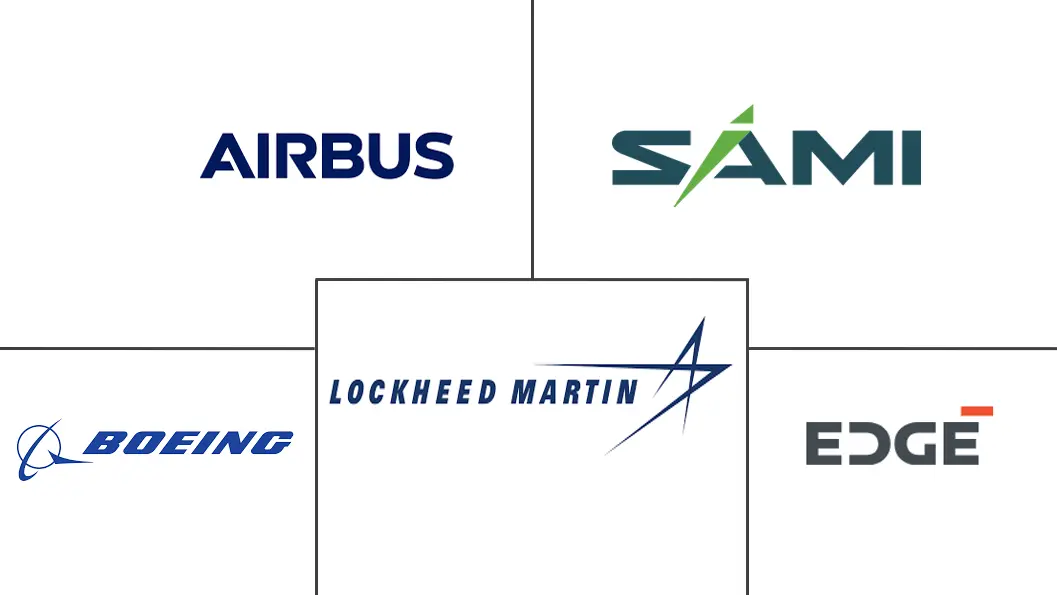Market Size of GCC Defense Industry

| Study Period | 2019 - 2029 |
| Base Year For Estimation | 2023 |
| Market Size (2024) | USD 29.73 Billion |
| Market Size (2029) | USD 50.19 Billion |
| CAGR (2024 - 2029) | 11.04 % |
| Market Concentration | Medium |
Major Players
*Disclaimer: Major Players sorted in no particular order |
GCC Defense Market Analysis
The GCC Defense Market size is estimated at USD 29.73 billion in 2024, and is expected to reach USD 50.19 billion by 2029, growing at a CAGR of 11.04% during the forecast period (2024-2029).
The current geopolitical tensions among the GCC (Gulf Cooperation Council) countries have resulted in armies' need to focus on enhancing their military power. To do so, they are investing in modernizing their air, land, and sea platforms by replacing their aging military equipment with new-generation equipment and upgrading the technology onboard their existing equipment.
However, this modernization process comes with challenges, including budget constraints and a lack of skilled labor, which could slow the procurement and maintenance of new equipment. Despite these challenges, there are also several opportunities for growth in the defense market in the region. Governments in the GCC are increasingly emphasizing the development of local defense manufacturing capabilities, which could lead to partnerships with international players and the expansion of the region's portfolio of defense products.
Moreover, advancements in technology, such as artificial intelligence and autonomous systems, are creating new avenues for growth in the defense market. Adopting these technologies in defense equipment could improve efficiency, reduce costs, and enhance the overall effectiveness of military operations.
GCC Defense Industry Segmentation
The GCC defense market covers all aspects, including details about the procurement and modernization plans of the GCC armed forces.
The GCC defense market is segmented by armed forces, type, and geography. By armed forces, the market is segmented into army, navy, and air force. By type, the market is segmented into personnel training and protection, communication systems, vehicles, and weapons and ammunition. The report also offers the market size and forecasts for six countries across the region. For each segment, the market sizing and forecasts are provided based on value (USD).
| By Armed Forces | |
| Army | |
| Navy | |
| Air Force |
| By Type | ||||||
| ||||||
| Communication Systems | ||||||
| ||||||
|
| By Geography | |
| Saudi Arabia | |
| United Arab Emirates | |
| Qatar | |
| Kuwait | |
| Bahrain | |
| Oman |
GCC Defense Market Size Summary
The GCC defense market is poised for substantial growth, driven by the need to enhance military capabilities amid ongoing geopolitical tensions. Countries within the Gulf Cooperation Council are investing heavily in modernizing their air, land, and sea defense platforms, replacing outdated equipment with advanced, next-generation systems. This modernization effort is supported by a strategic focus on developing local defense manufacturing capabilities, which is expected to foster partnerships with international defense players and expand the region's defense product portfolio. Despite challenges such as budget constraints and a shortage of skilled labor, the integration of advanced technologies like artificial intelligence and autonomous systems is anticipated to create new growth opportunities, improving the efficiency and effectiveness of military operations.
Saudi Arabia, in particular, is making significant strides in bolstering its defense industry through substantial investments aimed at modernizing its military capabilities. The country's defense budget, aligned with its Vision 2030 initiative, emphasizes increasing indigenous manufacturing and diversifying the economy. This has led to strategic partnerships and procurement of advanced defense systems, including missile defense and surveillance equipment. The GCC defense market is semi-consolidated, with major players like Lockheed Martin, Boeing, and Airbus, alongside regional entities such as Saudi Arabian Military Industries and EDGE Group. The trend towards indigenous production is gaining momentum, with regional players increasing their market share through collaborations and joint ventures, further accelerating the growth of the defense sector in the region.
GCC Defense Market Size - Table of Contents
-
1. MARKET DYNAMICS
-
1.1 Market Overview
-
1.2 Market Drivers
-
1.3 Market Restraints
-
1.4 Porter's Five Forces Analysis
-
1.4.1 Threat of New Entrants
-
1.4.2 Bargaining Power of Buyers/Consumers
-
1.4.3 Bargaining Power of Suppliers
-
1.4.4 Threat of Substitute Products and Services
-
1.4.5 Degree of Competition
-
-
-
2. MARKET SEGMENTATION
-
2.1 By Armed Forces
-
2.1.1 Army
-
2.1.2 Navy
-
2.1.3 Air Force
-
-
2.2 By Type
-
2.2.1 Personnel Training and Protection
-
2.2.1.1 Training and Simulation
-
2.2.1.2 Protection Equipment
-
-
2.2.2 Communication Systems
-
2.2.3 Vehicles
-
2.2.3.1 Land-based Vehicles
-
2.2.3.2 Sea-based Vehicles
-
2.2.3.3 Air-based Vehicles
-
-
2.2.4 Weapons and Ammunition
-
2.2.4.1 Artillery and Mortar Systems
-
2.2.4.2 Infantry Weapons
-
2.2.4.3 Missiles and Missile Defense Systems
-
2.2.4.4 Ammunition
-
-
-
2.3 By Geography
-
2.3.1 Saudi Arabia
-
2.3.2 United Arab Emirates
-
2.3.3 Qatar
-
2.3.4 Kuwait
-
2.3.5 Bahrain
-
2.3.6 Oman
-
-
GCC Defense Market Size FAQs
How big is the GCC Defense Market?
The GCC Defense Market size is expected to reach USD 29.73 billion in 2024 and grow at a CAGR of 11.04% to reach USD 50.19 billion by 2029.
What is the current GCC Defense Market size?
In 2024, the GCC Defense Market size is expected to reach USD 29.73 billion.

